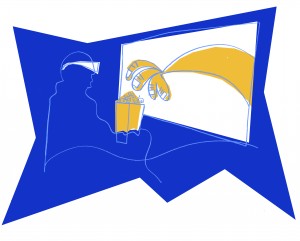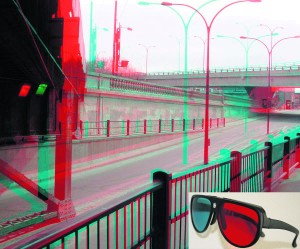MONDAY, 3 OCTOBER 2011
Clever applications of physics and the large market envisaged by the film industry have driven this technology rapidly forwards since its resurgence in the 1980’s. Many films these days are being made in 3D, but often the relatively simple technology behind them is poorly understood.The aim of 3D cinema is to replicate the experience we get when we look at the 3D world around us. Objects that are farther away look smaller to us and are also blocked from our vision by things that are closer.
Our eyes present us with two views of the same object, so that we have a better idea of where it is in 3D space—this is called stereopsis. Furthermore, eyes have to focus to see things more clearly, and since focusing depends on the distance to an object, this gives us a better idea of its position in 3D space too. Neither of these effects can be replicated using standard 2D films and, for now, only the first is actually in use in 3D cinema. However, eventually film-makers may even be able to make our eyes focus on objects on a cinema screen as though they were closer or farther away.
For a 3D film to persuade us that something is closer than the screen, the left eye must see the same object to the right of where the right eye sees it. The brain will assume that these two images are of the same object in the same position and it will interpret this as it would any other object for which this is the case—it will think that the object is closer to us. The opposite is true for objects that are supposed to be far away; if the left eye sees an image slightly to the left of where the right eye sees it, the brain will assume that it is farther away than the screen. As a result, 2D images appear to be 3D.
The most primitive form of 3D imaging is called anaglyph. You have probably tried this—it requires you to wear glasses with one red and one blue lens. Anaglyph images will then have some red and some blue parts to them: the red parts are filtered out by the red lens, allowing you to see only the blue parts, whilst the blue parts are blocked out by the blue lens, meaning you see only the red parts. This allows a film-maker to cause each eye to see something slightly different, fooling the brain into inferring a 3D image. The drawback of this method is that the quality of colour of any cinematic image may be compromised to some degree by the need to look through these coloured filters.
Some glasses use a more advanced version of this idea. One of the lenses lets through only certain wavelengths of light of various colours while blocking others out, whereas the other lens does the opposite. This can improve the quality of colour, but otherwise works very much like anaglyph.
There is a type of electronic glasses that use a completely different method. These work by blacking out one lens while a film shows what that eye should see and then blacking out the other lens. In order for the brain not to be bothered by this, the flickering has to be at a high frequency and must be completely in synchronisation with the film. This requires expensive glasses in which flickering can be kept in time with the film either by a wire, which is cumbersome, or wirelessly, which further raises the price of the glasses. For this reason, this method has not been widely used in 3D cinema.
Rather than sacrificing image colour quality with anaglyphs, or forcing viewers to pay huge prices to watch films with expensive glasses, the polarisation method is widely used. It allows for high colour quality but requires an expensive screen, as the polarisers only let half of the light through to each eye. This means that the colours in the film must be intensified, otherwise they could appear dimmed to viewers. However, it does allow for much cheaper glasses, reducing costs when hundreds of people watch the same viewing of a film. There are two types of polarisation that are used in 3D cinema, with both taking advantage of light waves oscillating perpendicular to the direction in which the light travels.
The simplest form of polarisation is plane polarisation. In normal light, the oscillation is in all directions at right angles to the light’s direction of travel, but if light is plane polarised by being passed through a filter, all the oscillations are in the same direction. For example, viewers can wear glasses with one lens polarised to block out the horizontally polarised light, only letting through the vertically polarised light and only letting the viewer see the image formed from vertically polarised light. The other lens can then do the opposite, blocking vertically polarised light and so providing the other eye with a different image: that in horizontally polarised light. The problem with this is that the glasses have to be kept completely straight; if they are tilted too far one way or the other, both eyes will start to be able to see both images, as the polarisers will not be orientated in the same direction as the light.
This effect can be avoided if circular polarisation is used instead. With circularly polarised light, as opposed to oscillating in just two planes, the light wave describes a circle. To create this, light must be first polarised in a horizontal and vertical direction, but the wavelengths are made to oscillate out of sync with one another by just a quarter of a wavelength. As these wavelengths approach the eye, the combination of the out of sync light waves is equivalent to them forming a circle.
A filter is made from an anisotropic material that forces the light to travel more slowly in one direction. Therefore, one of the planes of light becomes a quarter of a wavelength behind the other plane, creating the circular polarisation. Whether the horizontally or vertically polarised light is delayed determines whether the light is circularly polarised in a clockwise or an anti-clockwise direction. So that each eye sees only one of the images, the glasses must undo this polarisation. The light must travel through another layer of anisotropic material, so that it is plane polarised again, and then through a polariser. Clockwise and anti-clockwise polarised light travelling through the same anisotropic material would come out plane polarised at 90 degrees to each other. Each lens of the 3D glasses has a different plane polarised filter so each eye sees a different image, either horizontal or vertical waves, which the brain can convert into a 3D picture.
This is the method most commonly used in cinemas today. If you take two pairs of these 3D glasses, you can see that they work by circular and not plane polarisation. By wearing a pair with one eye open and looking at a friend wearing another pair, one of the lenses should appear blacked out. Furthermore, it should be the same lens regardless of how much you tilt your head.
3D cinema has come a long way since its invention. Through the early anaglyph images with fairly poor colour quality, we have now moved to glasses with polarisers that are capable of showing high quality 3D images. As this technology continues to develop, we can expect a cinema experience that will become more and more convincingly 3D.
Aaron Barker is a 4th year student in the Department of Earth Sciences



